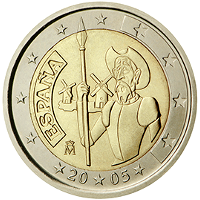 |
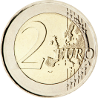 |
C o m m e m o r a t i v e
C o i n s |
||
| Spain | |||||||
The edge lettering of the Spanish 2‐euro‐commemorative coins is : |
 |
||||||
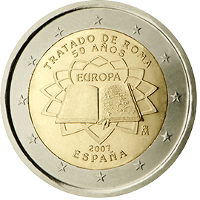
|
 |
Spain | 50th anniversary of the Signature of the Treaty of Rome | 20001 |  |
Volume : 8,000,000 Date of Issue : 25 Mar. 2007 Designer : Helmut Andexlinger Producer : Spanish mint Real Casa de la Moneda in Madrid (Mintmark = "M" adorned with a crown) |
|||||
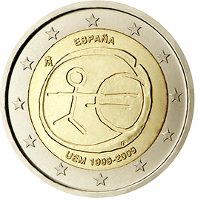
|
 |
Spain | 10th anniversary of the Economic and Monetary Union (EMU) | 20001 |  |
Volume : 8,000,000 Date of Issue : 02 Feb. 2009 Designer : Georgios Stamatopoulos ("ΓΣ") Producer : Spanish mint Real Casa de la Moneda in Madrid (Mintmark = "M" adorned with a crown) |
|||||
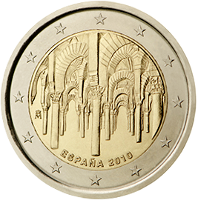
|
 |
Spain | Historic Centre of Córdoba (Mezquita‐Cathedral) 1st coin in the UNESCO World Heritage Sites series |
20001 |  |
Volume : 4,000,000 Date of Issue : 03 Mar. 2010 Designer : Alfonso Morales Muñoz Producer : Spanish mint Real Casa de la Moneda in Madrid (Mintmark = "M" adorned with a crown) |
|||||
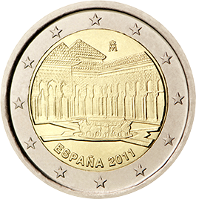
|
 |
Spain | Patio de los Leones of the Alhambra, Generalife and Albayzín, Granada 2nd coin in the UNESCO World Heritage Sites series |
20001 |  |
Volume : 4,000,000 Date of Issue : 21 Feb. 2011 Designer : Alfonso Morales Muñoz Producer : Spanish mint Real Casa de la Moneda in Madrid (Mintmark = "M" adorned with a crown) |
|||||
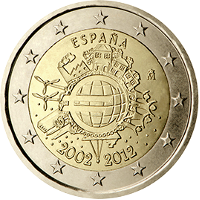
|
 |
Spain | 10th anniversary of the Euro‐Currency | 20001 |  |
Volume : 4,000,000 Date of Issue : 02 Jan. 2012 Designer : Helmut Andexlinger Producer : Spanish mint Real Casa de la Moneda in Madrid (Mintmark = "M" adorned with a crown) |
|||||
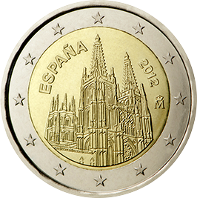
|
 |
Spain | Burgos Cathedral 3rd coin in the UNESCO World Heritage Sites series |
20001 |  |
Volume : 4,000,000 Date of Issue : 01 Mar. 2012 Designer : Alfonso Morales Muñoz Producer : Spanish mint Real Casa de la Moneda in Madrid (Mintmark = "M" adorned with a crown) |
|||||
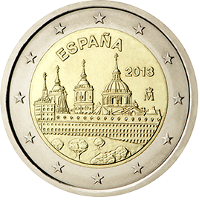
|
 |
Spain | Monastery and Site of the El Escorial, Madrid 4th coin in the UNESCO World Heritage Sites series |
20001 |  |
Volume : 4,000,000 Date of Issue : 02 Mar. 2013 Designer : Alfonso Morales Muñoz Producer : Spanish mint Real Casa de la Moneda in Madrid (Mintmark = "M" adorned with a crown) |
|||||

|
 |
Spain | Works of Antoni Gaudi (Park Güell) 5th coin in the UNESCO World Heritage Sites series |
20001 |  |
Volume : 4,000,000 Date of Issue : 07 Feb. 2014 Designer : Alfonso Morales Muñoz Producer : Spanish mint Real Casa de la Moneda in Madrid (Mintmark = "M" adorned with a crown) |
|||||
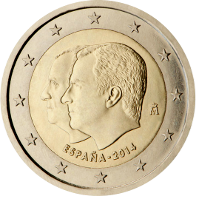
|
 |
Spain | King Felipe VI's accession to the throne | 20001 |  |
Volume : 8,132,500 Date of Issue : 10 Dec. 2014 Designer : Alfonso Morales Muñoz Producer : Spanish mint Real Casa de la Moneda in Madrid (Mintmark = "M" adorned with a crown) |
|||||

|
 |
Spain | Cave of Altamira and Paleolithic Cave Art of Northern Spain 6th coin in the UNESCO World Heritage Sites series |
20001 |  |
Volume : 4,104,700 Date of Issue : 30 Jan. 2015 Designer : Alfonso Morales Muñoz Producer : Spanish mint Real Casa de la Moneda in Madrid (Mintmark = "M" adorned with a crown) |
|||||
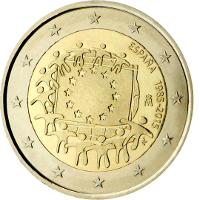
|
 |
Spain | 30th anniversary of the EU‐Flag | 20001 |  |
Volume : 4,300,000 Date of Issue : 01 Dec. 2015 Designer : Georgios Stamatopoulos ("ΓΣ") Producer : Spanish mint Real Casa de la Moneda in Madrid (Mintmark = "M" adorned with a crown) |
|||||
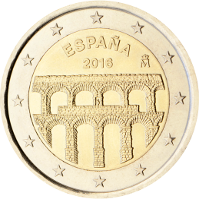
|
 |
Spain | Old town of Segovia and its aqueduct 7th coin in the UNESCO World Heritage Sites series |
20001 |  |
Volume : 3,400,000 Date of Issue : 05 Feb. 2016 Designer : Alfonso Morales Muñoz Producer : Spanish mint Real Casa de la Moneda in Madrid (Mintmark = "M" adorned with a crown) |
|||||
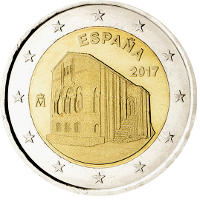
|
 |
Spain | Monuments of Oviedo and the Kingdom of Austurias (Santa Maria del Naranco) 8th coin in the UNESCO World Heritage Sites series |
20001 |  |
Volume : 536,520 Date of Issue : 03 Feb. 2017 Designer : Alfonso Morales Muñoz Producer : Spanish mint Real Casa de la Moneda in Madrid (Mintmark = "M" adorned with a crown) |
|||||
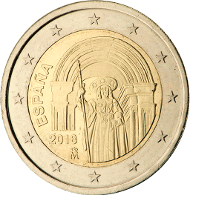
|
 |
Spain | Old town of Santiago de Compostela 9th coin in the UNESCO World Heritage Sites series |
20001 |  |
Volume : 333,700 Date of Issue : 02 Feb. 2018 Designer : Alfonso Morales Muñoz Producer : Spanish mint Real Casa de la Moneda in Madrid (Mintmark = "M" adorned with a crown) |
|||||
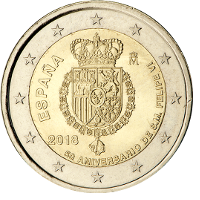
|
 |
Spain | 50th birthday of Felipe VI of Spain | 20001 |  |
Volume : 431,500 Date of Issue : 02 Feb. 2018 Designer : Alfonso Morales Muñoz Producer : Spanish mint Real Casa de la Moneda in Madrid (Mintmark = "M" adorned with a crown) |
|||||

|
 |
Spain | Old town of Ávila with its extra‐muros churches 10th coin in the UNESCO World Heritage Sites series |
20001 |  |
Volume : 500,000 Date of Issue : 01 Feb. 2019 Designer : Alfonso Morales Muñoz Producer : Spanish mint Real Casa de la Moneda in Madrid (Mintmark = "M" adorned with a crown) |
|||||
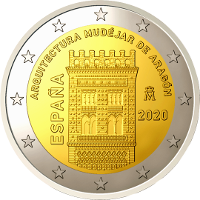
|
 |
Spain | Mudéjar Architecture of Aragon 11th coin in the UNESCO Wourld Heritage Sites series |
20001 |  |
Volume : 4,024,500 Date of Issue : 31 Jan. 2020 Designer : Alfonso Morales Muñoz Producer : Spanish mint Real Casa de la Moneda in Madrid (Mintmark = "M" adorned with a crown) |
|||||
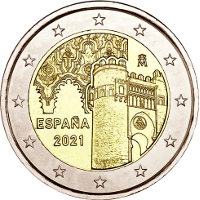
|
 |
Spain | Historic city of Toledo 12th coin in the UNESCO Wourld Heritage Sites series |
20001 |  |
Volume : 4,019,500 Date of Issue : 10 Mar. 2021 Designer : Alfonso Morales Muñoz Producer : Spanish mint Real Casa de la Moneda in Madrid (Mintmark = "M" adorned with a crown) |
|||||
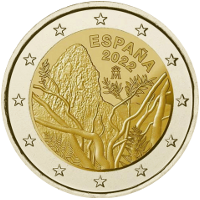
|
 |
Spain | Garajonay National Park 13th coin in the UNESCO Wourld Heritage Sites series |
20001 |  |
Volume : 1,019,300 Date of Issue : 23 Mar. 2022 Designer : Alfonso Morales Muñoz Producer : Spanish mint Real Casa de la Moneda in Madrid (Mintmark = "M" adorned with a crown) |
|||||
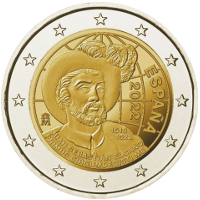
|
 |
Spain | 500th anniversary of the completion of the first circumnavigation | 20001 |  |
Volume : 1,019,000 Date of Issue : 23 Mar. 2022 Designer : Alfonso Morales Muñoz Producer : Spanish mint Real Casa de la Moneda in Madrid (Mintmark = "M" adorned with a crown) |
|||||
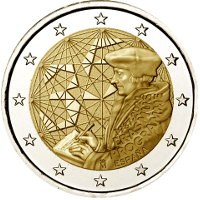
|
 |
Spain | 35th anniversary of the Erasmus Program | 20001 |  |
Volume : 1,018,500 Date of Issue : 01 Jul. 2022 Designer : Joaquin Jimenez Producer : Spanish mint Real Casa de la Moneda in Madrid (Mintmark = "M" adorned with a crown) |
|||||
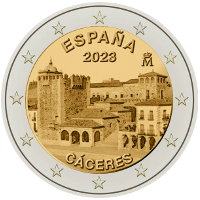
|
 |
Spain | Old Town of Cáceres 14th coin in the UNESCO Wourld Heritage Sites series |
20001 |  |
Volume : 1,518,500 Date of Issue : 28 Mar. 2023 Designer : Alfonso Morales Muñoz Producer : Spanish mint Real Casa de la Moneda in Madrid (Mintmark = "M" adorned with a crown) |
|||||
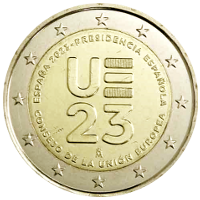
|
 |
Spain | EU Presidency 2023 | 20001 |  |
Volume : 1,506,500 Date of Issue : 03 Jul. 2023 Designer : Alfonso Morales Muñoz Producer : Spanish mint Real Casa de la Moneda in Madrid (Mintmark = "M" adorned with a crown) |
|||||
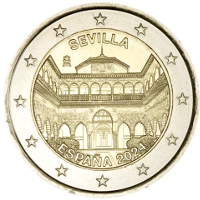
|
 |
Spain | Cathedral, Alcazar und Archivo de Indias in Seville 15th coin in the UNESCO Wourld Heritage Sites series |
20003 |  |
Volume : 1,525,000 Date of Issue : 02 Feb. 2024 Designer : Alfonso Morales Muñoz Producer : Spanish mint Real Casa de la Moneda in Madrid (Mintmark = "M" adorned with a crown) |
|||||
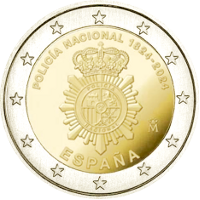
|
 |
Spain | 200 years of the Spanish National Police | 20003 |  |
Volume : 1,521,300 Date of Issue : 02 Feb. 2024 Designer : Alfonso Morales Muñoz Producer : Spanish mint Real Casa de la Moneda in Madrid (Mintmark = "M" adorned with a crown) |
|||||
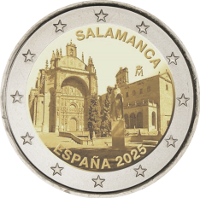
|
 |
Spain | Old town of Salamanca 16th coin in the UNESCO Wourld Heritage Sites series |
20003 |  |
Volume : 2,000,000 Date of Issue : 10 Mar. 2025 Designer : Alfonso Morales Muñoz Producer : Spanish mint Real Casa de la Moneda in Madrid (Mintmark = "M" adorned with a crown) |
|||||
| References : | |||
| 20001 | Images taken with authorisation by the ECB ‐ Mail dated 20.Feb.2020 © "European Central Bank" |
20002 | Not Applicable |
| 20003 | Images taken temporally from the Internet | 20004 | Not Applicable |
